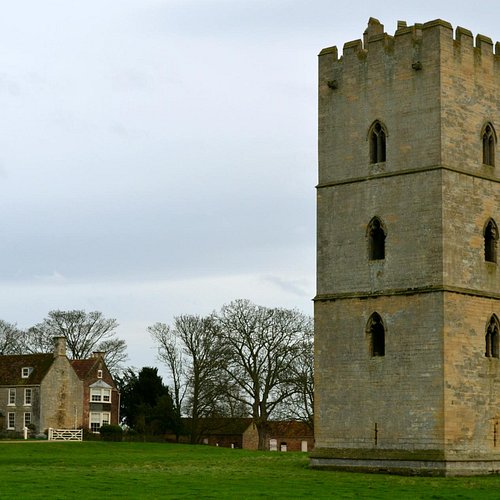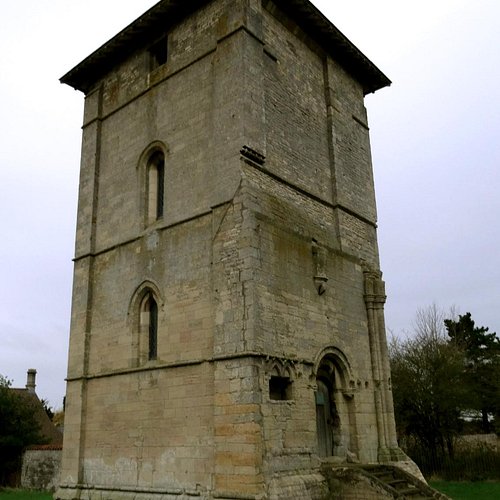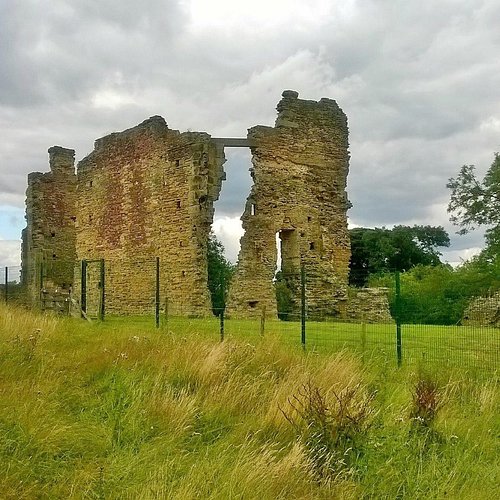What to do and see in East Midlands, England: The Best Ancient Ruins
Discover the best top things to do in East Midlands, United Kingdom including Rufford Abbey Country Park, Crowland Abbey, Wingfield Manor, South Kyme Tower, Temple Bruer - Knights Templar Church Ruin, Towcester Castle ( Bury Mount), Jewry Wall, Codnor Castle, Fotheringhay Castle, Rufford Abbey.
Restaurants in East Midlands
1. Rufford Abbey Country Park
Overall Ratings
4.5 based on 938 reviews
A beautiful country park set around the 12th-century ruins of Rufford Abbey. Gardens, lakeside walks & woodland, shops, cafe, restaurant, tea shop, and a small exhibition about the life of the medieval monks who once lived here. Play area for young children. Good access for prams, pushchairs, mobility scooters and wheelchairs. Accessible loos. We open every day except Xmas Day and it's free to enter. Car park charge. Dogs welcome on a lead. A relaxing and magical place to visit.
Reviewed By 786carolb - Birmingham, United Kingdom
Friday 29 November 19, my friend and I visited historic Rufford Abbey. It was a really cold wintery day with a lovely winter sun. In 1146 Gilbert de Gaunt, Earl of Lincoln, founded the Cistercian abbey of St Mary the Virgin. The monks of this order, also known as the ‘white monks’ because of their habits of undyed wool, believed in the value of an austere life based upon prayer and hard work. Rufford Abbey was moderately wealthy and able to sustain a community of monks between its completion in about 1170 and its suppression in 1536. Rufford was one of the first abbeys in England to be affected by the Suppression of the Monasteries, and the whole estate was quickly acquired by George Talbot, 4th Earl of Shrewsbury. The conversion of the west range of monastic buildings into a house (1560–90) was undertaken by the sixth earl, who was the fourth and final husband of the indomitable Bess of Hardwick, from whom he was then bitterly estranged. In 1610, a new projecting wing was added to the northern end of this range. The estate was inherited in 1626 by Mary Talbot, sister of the 7th and 8h Earls of Shrewsbury, and it passed to her husband, George Savile. William Savile, George’s successor, made Rufford Abbey the seat of the Savile family after he burnt down the Saviles’ original home in order to prevent its being occupied by a Parliamentarian garrison during the Civil War. In 1679, the Savile family constructed a new north wing on the site of the abbey church, containing reception rooms and a long gallery. They also built the large stable block to the right of the house. The surviving roofed southern service wing (currently used as offices) was also added by the Saviles in the 17th century. In 1938, the 3rd Baron Savile inherited the Rufford estate as a minor, but his trustees split it into lots and sold it off. In the 20th Century the abbey and park were bought by Nottinghamshire County Council in 1952, and the north and east wings were demolished in 1956. The remaining west range and south service wing were put into the care of the Ministry of Works at the same date. My friend and I walked round this lovely abbey and then we strolled through the lovely sculpture gardens and took some wonderful photographs. I even found inspiration here for I wrote a poem call 'The Rose In Winter'. My friend and I then looked round the lovely Xmas Craft Shops and I purchased some 'Foxy' Xmas tree decorations, some Xmas cards and a classic book 'Cider With Rosie'. Afterwards, My friend and I then visited 'The Coach House' Café, where we had hot fish finger butties and a latte for me and tea for my friend. We spent a nice hour here getting warm after our lovely walk round the abbey and grounds. If you want a lovely place to visit or walk at any time of the year, then Rufford Abbey is a must.
2. Crowland Abbey
Overall Ratings
4.5 based on 87 reviews
Crowland Abbey is steeped in history and legends. An abbey has stood on the site since 716 and some remaining parts date back to Norman times. The original north aisle of the monastery church is intact (now the parish church) and ruins of the original Nave enable the visitor to imagine its original splendour. Whether your interests lie in architecture, history, the church, or people you will find something here to interest you. Guides are usually available who will tell you of the history and stories associated with the building and an interesting visitor centre has recently been introduced. Self-guided tours are available and, if you are bringing children, let them try our children's trails/quizzes that will keep them entertained.
Reviewed By isaacl782
I came here with a group of schoolchildren to learn about the abbey, its history and the broader history of the Church in England. We were welcomed with the most wonderful spread of refreshments and a veritable host of engaging and knowledgeable guides drawn from, I believe, the local community. Their hospitality and engagement with us was something truly wonderful. This is to say nothing, of course, about the building itself, which is full of interesting curiosities both within the remaining coherent structure and amongst the ruins. There is a brilliant and informative exhibition at the west end of the nave as well, as well as an intact original chancel screen (with some later restorations). I hope to return to Crowland next summer with the next incarnation of our trip!
3. Wingfield Manor
Overall Ratings
4.5 based on 17 reviews
Reviewed By 997briant - London, United Kingdom
We were walking on a public footpath today in rural Derbyshire, and the wonderful (though distant) views it afforded of the ruins of this once spectacular manor house reminded me of a mental note I made back in September 2017 following a guided tour of the manor, to write a timely review when the manor was once again open to the public in 2018. After all, that's when visitors are most likely to look it up on TripAdvisor to determine whether or not it's worth visiting. And it is worth visiting, without a shadow of a doubt. It's a real gem, crowning a rise on the edge of the Derbyshire Dales, and is an absolute must for aficionados of English history, castles and stately homes. HOWEVER, it's only open on six Saturdays every year, for private tours which must be booked in advance. It's part of a working farm, and entry other than on the tour is not possible (though you can admire it from afar, as we did today). The manor is in the care of the English Heritage. Guided tours are available, but only take place the first Saturday of every month between April and September, rain or shine. You'll need to book on-line, and meet your tour guide at the entrance to the farm on Garner Lane, South Wingfield (a village about four miles from the larger town of Alfreton). Ticket costs are very reasonable: £6.60 for adults, slightly reduced for concession holders. Of course English Heritage members will go free. The guided tour was outstanding. You'll be taken through the all ruins of the once-palatial manor house, sadly now in quite a state of disrepair (but a photographer's paradise). You'll see numerous rooms, old courtyards, and the spectacular undercrofted Great Hall, and you'll also be allowed (in small groups) to climb up the 72 feet tall Great Tower, for spectacular views of the Derbyshire countryside. The guide was extremely knowledgeable and gave a great, light-hearted and interesting commentary on the history of the house and some of the stories coming from the house. You'll have plenty of time to browse, take photographs, and to take all in. It is private property, so you won't be able to wander off and do your own thing; you are asked to be respectful of the fact that it is private property and on a working farm. The history of the house is really quite extraordinary. It was built in the 1440s for Ralph de Cromwell; Mary Queen of Scots was imprisoned here a number of times in the late 1550s. I fully recommend this tour; it's one of those hidden little finds that you will remember! There 's a lay-by parking bay a short 300 yard walk from the entrance to the manor. The 140 or 142 buses from the nearby town of Alfreton will take you to the village of South Wingfield, a short walk from the tour meeting point! Enjoy your visit!
4. South Kyme Tower
5. Temple Bruer - Knights Templar Church Ruin
Overall Ratings
4.5 based on 8 reviews
Reviewed By Bishy008 - Market Deeping, United Kingdom
Not easy to find, but worth the effort. Only one tower remains of what was a large Templar complex. Thd history has been well researched and is explained on a number of informatikn boards. Entry is free.
6. Towcester Castle ( Bury Mount)
Overall Ratings
4.5 based on 2 reviews
Reviewed By shanes236 - Northamptonshire, United Kingdom
Thought to date back to the 11th century, this earthwork motte and bailey adds a little bit of history to the roman town of Towcester. I visited yesterday and although the area surrounding is very attractive, sadly due to neglect there is hardly anything left of the castle itself. There are some steep stairs which lead you to the top and this enables nice views out onto the nature reserve/ park and stream . There is a small short stay car park located in Northampton road and this lovely little piece of history is well worth an hour or so. Very nice but nothing left. Visited June 8th 2020.
7. Jewry Wall
Overall Ratings
4.0 based on 165 reviews
Please note Jewry Wall Museum is currently closed for refurbishment. The Roman Jewry Wall and archaelogical site is still available to view.
Reviewed By mouseHerts
Leicester is not well known for its Roman past but there was quite a large settlement there for many centuries. All that is on display now is the Jewry wall and the remains of the quite extensive bath complex. We would have liked to find out more information but unfortunately the museum was closed for refurbishment.
8. Codnor Castle
Overall Ratings
4.0 based on 27 reviews
Reviewed By Quest369609
Codnor Castle is a major historical site, sadly nothing like as well known as it deserves. With a rich history stretching back over 800 years, the romantic and evocative ruins remaining are well worth a visit. It isn't easy to get to as cars are not allowed on the bridleway leading up to it but the walk from Codnor is a nice way to pass half an hour and the castle is well worth a visit. Ordinarily there are no facilities on site but the Codnor Castle Heritage Trust hold excellent open days monthly when this damn virus isn't with us and I'd highly recommend a visit to such an event when they re-start.
9. Fotheringhay Castle
Overall Ratings
4.0 based on 10 reviews
Reviewed By kempdj - Peterborough, United Kingdom
Just a short walk out of the village and on the banks of the river Nene are the remains of the castle which was the birthplace of Richard III and the site of Mary, Queen of Scots' execution. All that remains is the castle mound, moat (dried up) and a fragment of wall which has two plaques commemorating the two events. A beautiful site and fantastic views along the river it is worth the short climb up to the top of the mound. Another display near the entrance explains more about the castle.
10. Rufford Abbey
Overall Ratings
4.0 based on 9 reviews
Reviewed By Edward02 - Rotherham, United Kingdom
I met a friend for a walk round Rufford Country Park on a lovely sunny September day. Very well organised and Covoid safe. Plenty of places to sit and relax, have a picnic and sit in the sun. Car parking is £4 for the day and you can buy your ticket in advance. A great day out.










